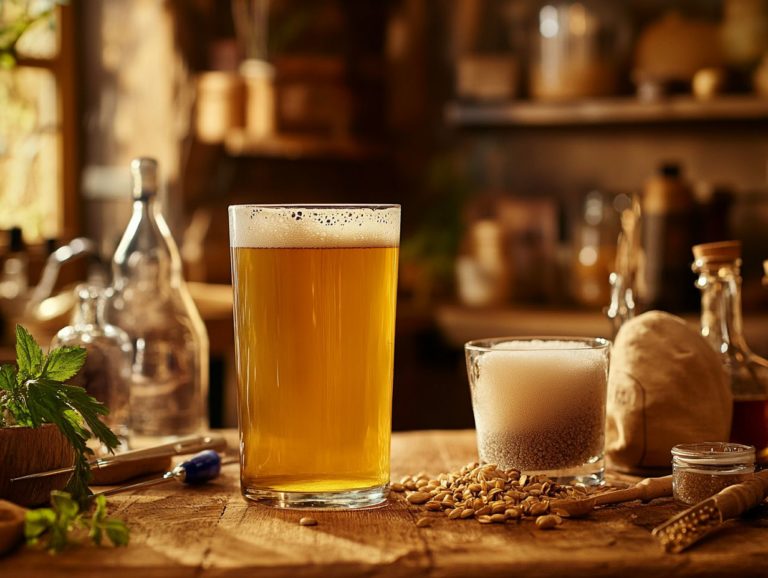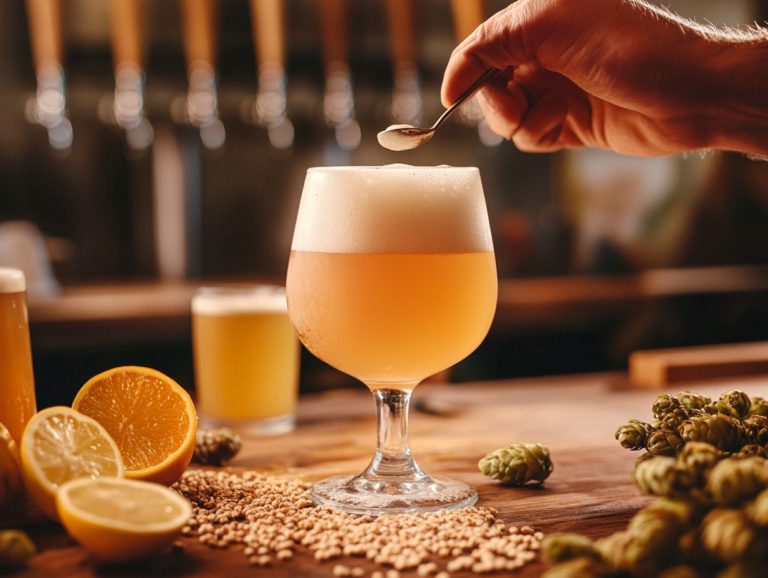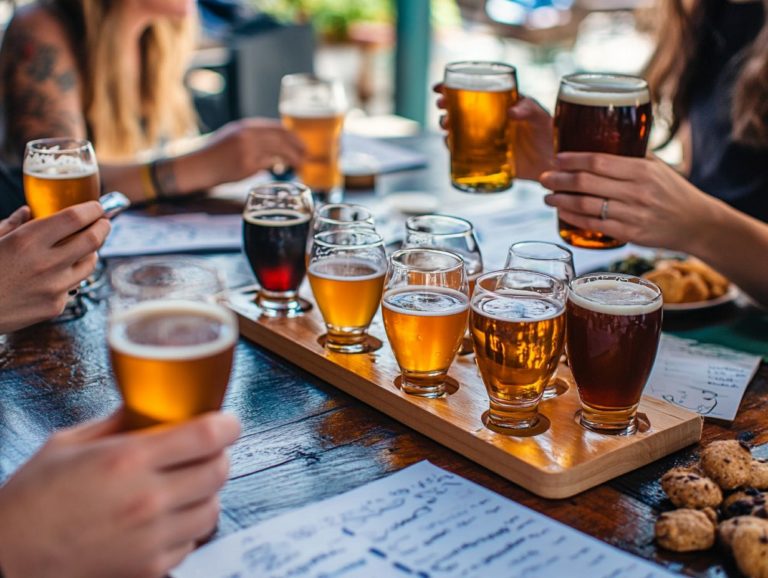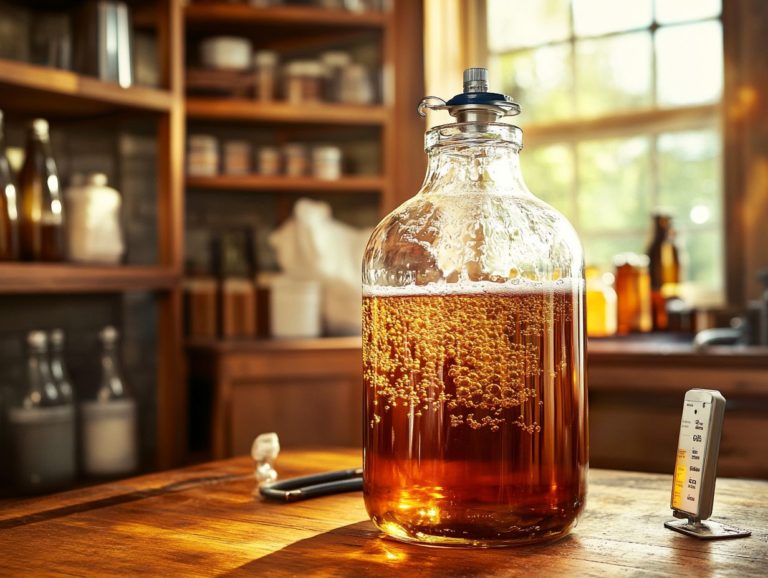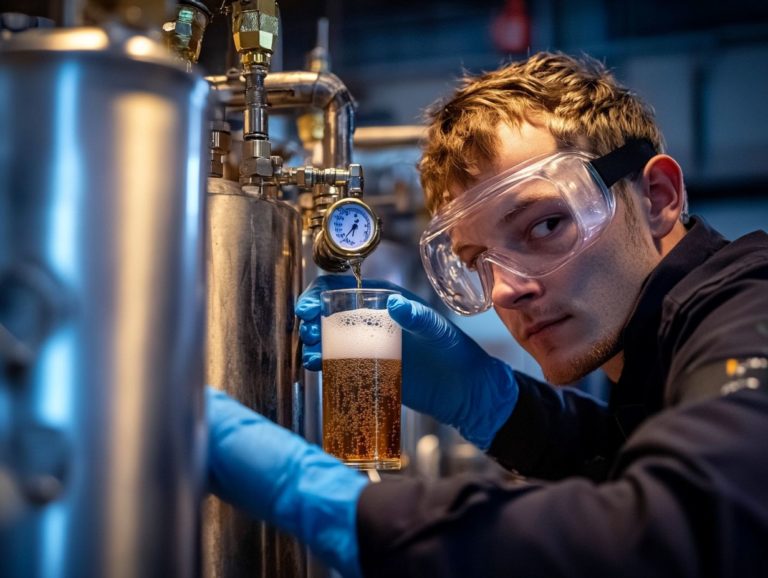5 Common Home Brewing Errors to Avoid
Contents
- Common Home Brewing Mistakes to Avoid
- Key Takeaways:
- 1. Not Sanitizing Brewing Equipment Properly
- 2. Not Controlling Fermentation Temperature
- 3. Not Following the Recipe Correctly
- 4. Using Old or Contaminated Ingredients
- 5. Rushing the Process
- How Can These Errors Affect the Final Product?
- Frequently Asked Questions
- What Are the Key Steps to Follow When Brewing?
- How Can One Ensure the Freshness and Quality of Ingredients?
- Why Is Patience Important in Home Brewing?
- What are the 5 most common home brewing errors to avoid?
- How can contamination be prevented during the home brewing process?
- What are the risks of using old ingredients in home brewing?
- What is the importance of temperature control in home brewing?
- How can I ensure that I am following instructions properly while home brewing?
- What should I do if I make a mistake while home brewing?
Common Home Brewing Mistakes to Avoid
Home brewing can be an incredibly rewarding and enjoyable hobby. However, even the most dedicated brewers may find themselves falling into common traps that compromise the quality of their creations. These beginner mistakes can often be avoided with proper knowledge and practice.
Improper sanitization of equipment, neglecting fermentation temperature, and under pitching yeast are just a few of the beginner mistakes that can lead to disappointing outcomes. This article delves into five key pitfalls you ll want to steer clear of, explaining how each misstep can affect your brew. This article also offers best practices and homebrew tips designed to ensure your home brewing experience is not only successful but thoroughly satisfying.
Key Takeaways:
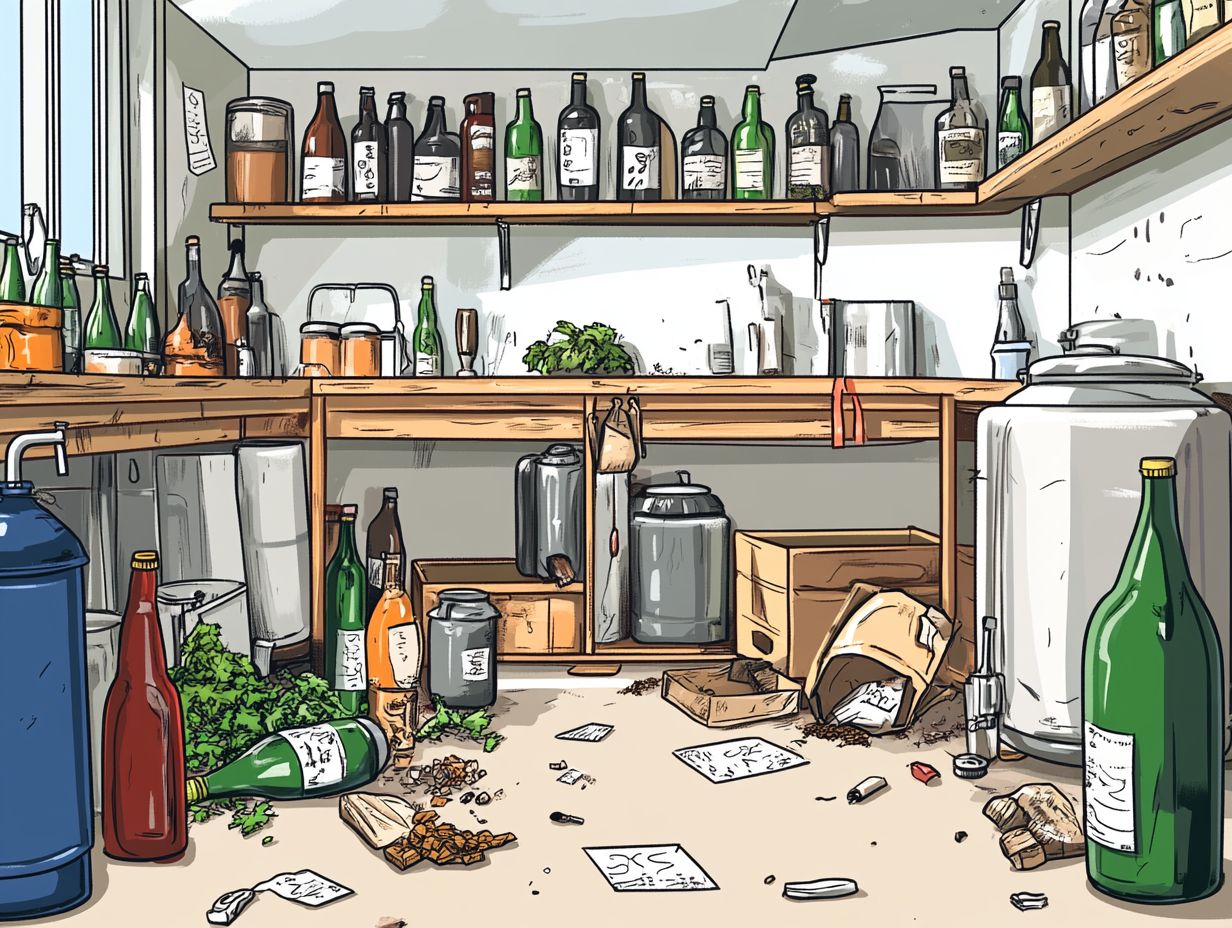
- Sanitize all brewing equipment to prevent contamination.
- Maintain consistent fermentation temperatures for the best flavors.
- Follow recipes closely to achieve the desired taste.
1. Not Sanitizing Brewing Equipment Properly
Not properly sanitizing your brewing equipment can lead to contamination. This results in off-flavors and potential spoilage in your home brew something that many beginners often overlook. Understanding the importance of cleaning and sanitation is essential!
Experts like David Ackley and Charlie Papazian advocate for using effective sanitizers such as Star San and Iodophor to ensure a successful fermentation. However, it’s not just about selecting the right sanitizers; you also need to recognize which pieces of equipment require thorough sanitization.
This includes fermenters, airlocks, brew kettles, and even your utensils. Failing to sanitize these items allows unwanted microorganisms to thrive, which can compromise your entire brewing effort and lead to undesirable flavors or even a complete batch failure.
Forums like HomeBrewTalk and research from the Institute of Brewing and Distilling can provide invaluable insights into best practices. Neglecting sanitation can quickly turn your brewing fun into a frustrating ordeal!
That s why adopting a disciplined approach to cleanliness is crucial for anyone aspiring to create quality craft beverages.
2. Not Controlling Fermentation Temperature
Controlling fermentation temperature is absolutely crucial in home brewing. Fluctuating temperatures can significantly affect yeast fermentation and the overall flavor profile of your beer. Mastering temperature control is essential, especially during wort boiling and yeast culture activities.
Different beer styles thrive at various fermentation temperatures. For instance, lagers typically prefer a cooler environment, fermenting best between 45-55 F, while ales enjoy a warmer range of 60-72 F. To maintain these optimal conditions, you might find it worthwhile to invest in equipment like fermentation chambers or temperature controllers.
Using a hydrometer for accurate measurements can aid in maintaining consistency. Any significant deviations from these temperature ranges can lead to undesirable outcomes, such as off-flavors or stalled fermentation, which could easily ruin a batch.
By understanding and managing these aspects of the brewing process, you can elevate your brewing efforts from novice to expert. Achieving results that truly reflect the art of fine craft brewing is possible! For more detailed guidance, consider resources like Local Beer Blog and advice from experts like Bryan Roth.
In conclusion, avoiding these common pitfalls will enhance your home brewing experience. By implementing the best practices outlined in this article, you can enjoy the satisfying journey of crafting your own unique beverages!
3. Not Following the Recipe Correctly
Not following the recipe correctly is a common pitfall for novice brewers. It can lead to significant variations in the final product. To achieve consistency, it’s essential to thoroughly understand the brewing process including important elements like wort gravity (the density of the liquid before fermentation), ingredient measurements, and fermentation temperature, as highlighted in various brewing checklists. This is a lesson that seasoned experts, such as Charlie Papazian, often emphasize.
As you embark on your brewing journey, the brewing process can seem complicated at first, but mastering the recipe is crucial for your success. Each ingredient plays a vital role in shaping the flavor and quality of your brew. Even slight deviations from the specified amounts can result in unexpected and often undesirable flavors. Take the time to carefully read and interpret recipes. Highlight key steps and familiarize yourself with terms like “boil time” and “hops additions.” Utilizing a yeast starter (a method to promote healthy fermentation) can also ensure a robust fermentation process.
Consider utilizing brewing apps or journals to streamline your process. These tools can make it easier to track adjustments and outcomes, enhancing your brewing experience. Refer to resources like Mr. Malty for pitching rate calculators. They can significantly aid in achieving consistency. By adopting this meticulous approach, you can learn, adjust, and ultimately perfect your craft with every brewing session.
4. Using Old or Contaminated Ingredients
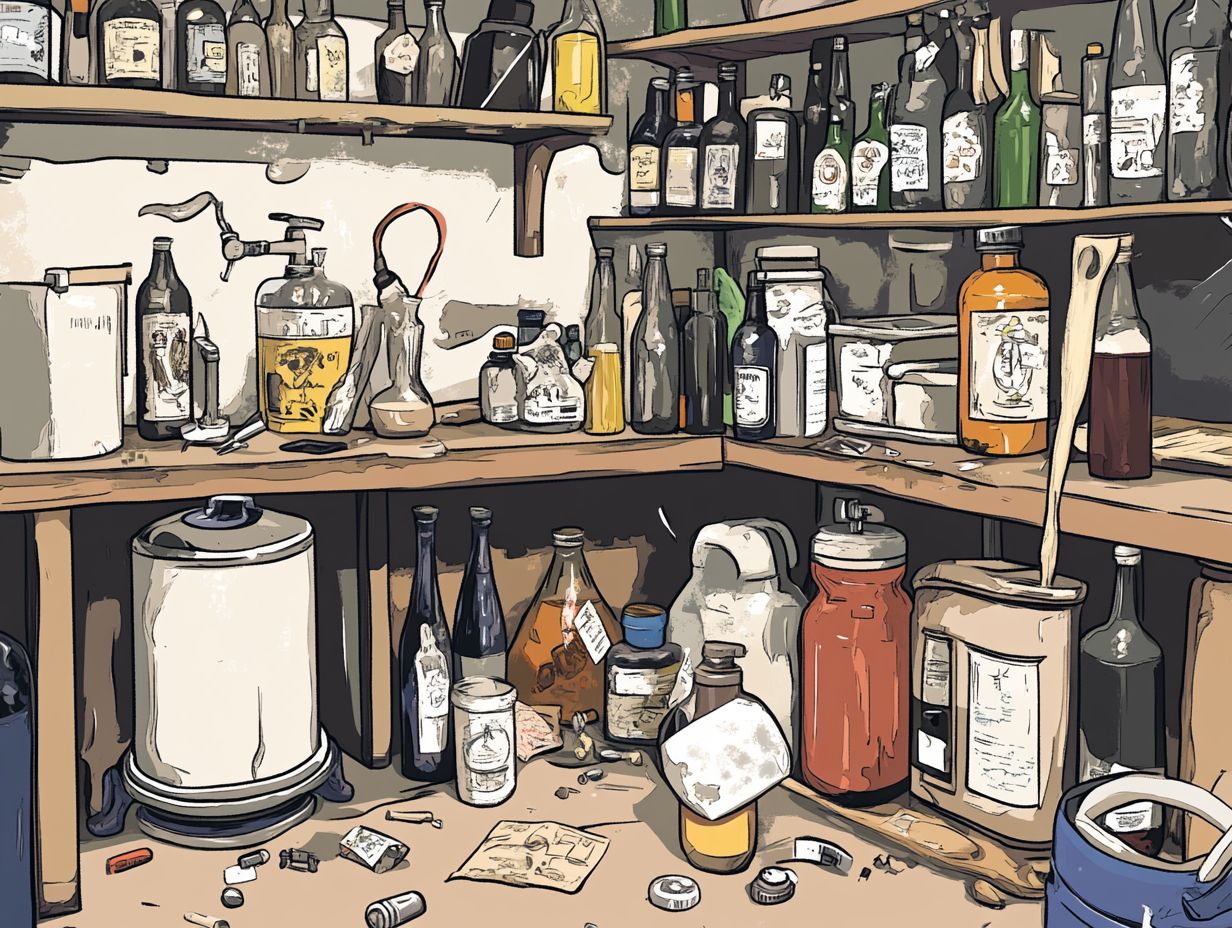
Using old or contaminated ingredients can severely compromise the quality of your home brew. This underscores the critical importance of ingredient quality and freshness in crafting exceptional craft beer. Experts like Bryan Roth from Local Beer Blog emphasize the necessity of maintaining a proper yeast culture and steering clear of outdated hops or malt.
To achieve the best results, it s essential to familiarize yourself with identifying fresh ingredients. Choosing vibrant, aromatic hops and checking your malt for a bright, crunchy texture can significantly enhance the flavor of your brew. Always paying attention to the quality of your ingredients is a standard practice among seasoned brewers, as emphasized in forums like HomeBrewTalk.
Understanding the shelf life of various brewing components is equally important. Yeast typically lasts a few weeks when stored correctly, while hops should ideally be used within six months for optimum potency. Practicing the best methods for storing these ingredients such as keeping them in a cool, dark place and using airtight containers will help maintain their integrity. Proper storage techniques are often discussed in communities like HomeBrewTalk and emphasized by experts from the Institute of Brewing and Distilling.
This way, every batch of beer you create is not just delightful but also a true reflection of your passion and skill as a brewer.
5. Rushing the Process
Rushing your home brewing can lead to unexpected and frustrating results! Patience is an essential virtue in achieving optimal fermentation and proper bottle conditioning. Taking the time to meticulously manage steps like adding priming sugar and allowing for adequate fermentation can truly make all the difference in the final product.
This careful approach encompasses several stages, beginning with the fermentation phase, where yeast works its magic, converting sugars into alcohol. During this crucial period, it s wise to resist the temptation to bottle too soon; doing so can disrupt the delicate balance of flavors you ve worked so hard to cultivate.
The patience you exhibit not only elevates the drink’s complexity but also significantly reduces the risk of those dreaded bottle bombs caused by excessive carbonation. Allowing flavors to develop over time will also help you avoid those unpleasant off-flavors that can arise from a hasty brewing process. This careful approach is essential for successful bottle conditioning, ensuring your brew reaches its full potential.
In the end, investing that time pays off, yielding a beverage that’s not only more enjoyable but also safer, showcasing the truly rewarding nature of this craft.
Home brewing can be both an art and a science. To achieve the best results, understanding common mistakes and how to avoid them is crucial.
How Can These Errors Affect the Final Product?
Errors in home brewing, such as neglecting to sanitize your equipment properly or failing to keep a close eye on fermentation, can lead to a cascade of issues that tarnish your final product. We’re talking contamination, off-flavors, and even brewing safety concerns like exploding bottles.
Often, these missteps arise from beginners worrying about brewing and not fully grasping its nuances. For example, if you overlook proper sanitation protocols, you might unwittingly give unwanted bacteria the chance to thrive.
This could result in a sour, unpleasant beer instead of the crisp, refreshing brew you envisioned. If you don t keep fermentation temperatures in check, you could end up with undesirable esters and phenols that drastically alter your beer’s flavor profile.
Investing in simple tools like a hydrometer can help track these variables more accurately. The fallout from these blunders goes beyond just taste; improperly managed fermentation can create excessive pressure in sealed bottles, leading to the very real risk of dangerous explosions.
That s why it s essential for home brewers like you to invest time in mastering these fundamental techniques. By addressing common beginner mistakes, you not only enhance your brewing results but also ensure a safer and far more enjoyable brewing experience.
These tips will help you get ready for events like Oktoberfest or simply impress your friends with a well-crafted Hefeweizen!
What Are the Best Practices for Sanitizing Equipment?
Regarding sanitizing your equipment for home brewing, following best practices is vital. The proper use of effective sanitizers like Star San and Iodophor ensures that all your brewing gear is meticulously cleaned and free of any contaminants. This is a crucial step for achieving brewing success.
Always remember, thorough cleaning and sanitation are the bedrock of any successful brew day. Start by thoroughly cleaning all your equipment with hot water and a suitable detergent, making sure to eliminate any residues from previous brews.
After rinsing everything well, prepare your sanitizer solution according to the manufacturer’s guidelines. For example, you would typically use Star San at a concentration of 1 ounce per 5 gallons of water.
Don’t overlook the importance of soaking all utensils, fermenters, and surfaces for the specified time to guarantee effective sanitization. Common pitfalls include skipping the cleaning phase before sanitizing, which can result in unwanted flavors or infections.
Failing to allow sufficient contact time with the sanitizer or using contaminated water could jeopardize your entire brewing endeavor. By following these essential steps, you significantly enhance your chances of crafting high-quality beer that could stand out at Oktoberfest.
How Can One Control Fermentation Temperature?
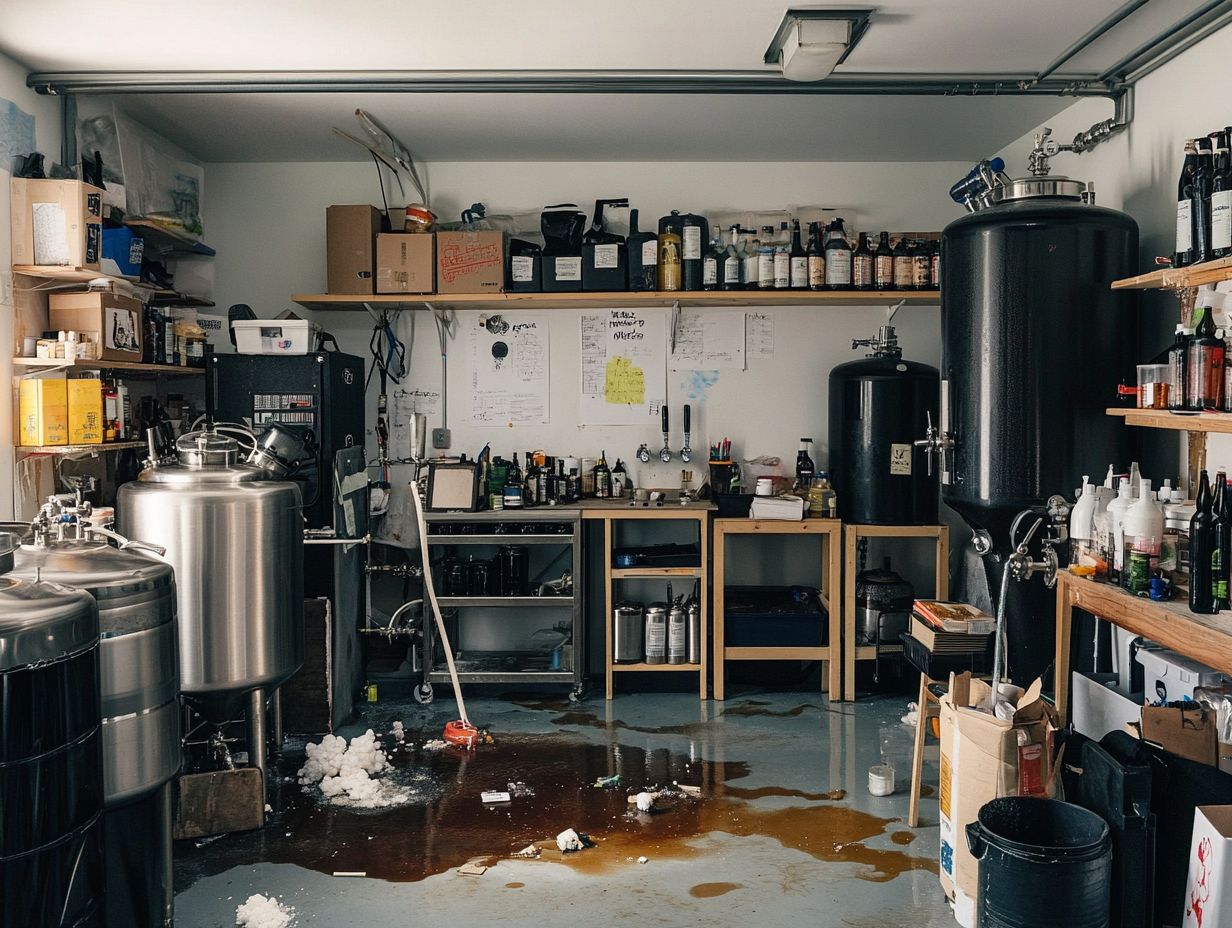
Controlling fermentation temperature is crucial for your home brewing success. Maintaining the ideal fermentation temperature can significantly influence yeast activity and the development of flavors in your final product.
Techniques such as utilizing temperature-controlled fermentation chambers can help you achieve that perfect balance. For more insight, check out the Institute of Brewing and Distilling.
Along with fermentation chambers, consider using a brew belt or heating pad to provide supplemental warmth during those chilly months. Conversely, placing your fermenter in a cooler area with ice packs can help mitigate temperature spikes.
Investing in a reliable thermometer or temperature controller is also advisable, as it will give you real-time readings, allowing for timely adjustments. Don’t forget about pH control, which is crucial in maintaining the ideal environment for your yeast.
Regularly monitoring the fermentation process is key to preventing drastic temperature fluctuations that could negatively impact your beer’s characteristics. Adjusting the ambient environment by insulating the fermenter or employing fans can further stabilize the temperature, ensuring that the yeast performs optimally throughout your brewing journey.
Popular resources like Mr. Malty and HomeBrewTalk can provide further tips on fermentation control. Don t wait! Start perfecting your brewing skills today!
Frequently Asked Questions
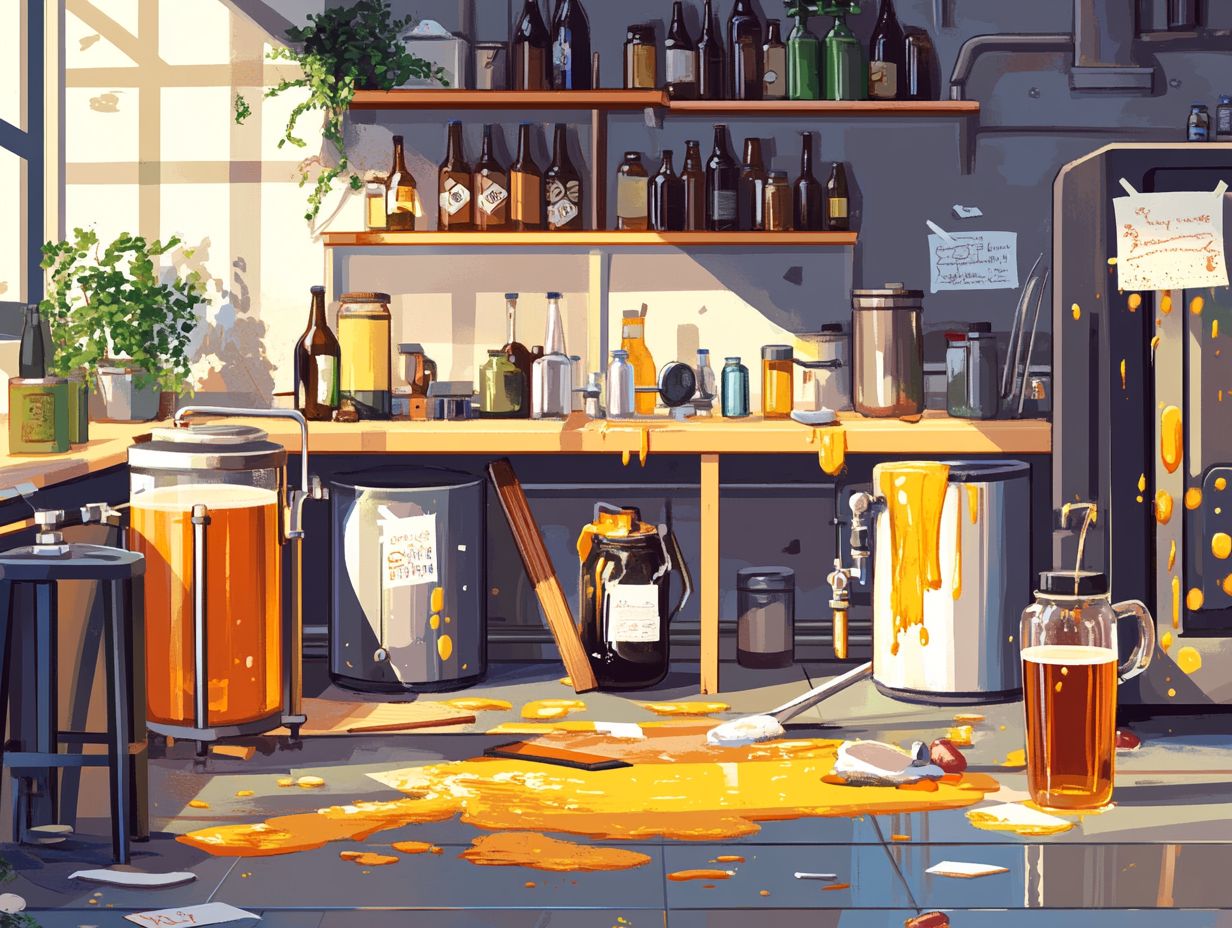
What Are the Key Steps to Follow When Brewing?
The key steps to follow when brewing involve careful steps, starting with a brewing checklist that outlines everything from boiling the wort (the liquid extracted from the malted grains) to managing the yeast culture using equipment like a Corona mill or a Blichmann pot. This makes brewing easier and ensures that your brewing process is smooth and efficient.
This checklist not only makes brewing easier but also acts as a vital reference point, helping you avoid the pitfalls of missed steps. Before diving in, gather all the necessary ingredients and equipment, double-checking each item to prevent any last-minute scrambles. Ensure you have proper sanitizers like Star San or Iodophor ready to keep contamination at bay.
Timing is crucial. Every phase, from mashing to fermentation (the process where yeast converts sugars into alcohol), requires precise attention to guarantee optimal flavor extraction and yeast activity.
Keep in mind that brewing is both an art and a science. By acknowledging each stage with careful attention, you can significantly elevate the quality of the final product.
How Can One Ensure the Freshness and Quality of Ingredients?
Ensuring the freshness and quality of your ingredients is vital in home brewing, as your choice directly impacts the flavor, aroma, and overall quality of the craft beer you produce. This means sourcing high-quality malts and hops while maintaining a robust yeast culture. Influential brewers like David Ackley and Charlie Papazian often emphasize the importance of ingredient quality.
Using stale ingredients can lead to undesirable off-flavors in your final product. Proper storage methods are key to preserving these ingredients, so keep them in a cool, dark place and use airtight containers to limit exposure to humidity and oxygen.
High-quality ingredients not only enhance the taste but also contribute to a more enjoyable brewing experience. They allow you to experiment with different profiles and truly appreciate the nuances of your craft. For example, brewing a Hefeweizen requires high-quality wheat malt to achieve its signature flavor. By carefully selecting your ingredients, you can significantly elevate your brewing journey.
Why Is Patience Important in Home Brewing?
Patience stands as a cornerstone of successful home brewing. Rushing through fermentation and bottle conditioning can lead to undesirable outcomes, such as off-flavors or even the dreaded exploding bottles. Allowing yeast to fully ferment and priming sugar to carbonate properly is essential for achieving the best flavor profile.
When you take the time to let the yeast work its magic during fermentation, you encourage the development of complex flavors and aromas. For instance, a robust ale can significantly benefit from an extended fermentation period, during which the yeast actively produces esters and phenols that elevate the final product. Seek out expert advice from figures like Bryan Roth to improve your brewing skills!
During bottle conditioning, your patience allows natural carbonation to occur, helping the beer achieve a smooth mouthfeel and a pleasing head. This maturation process ensures that the residual flavors meld harmoniously, resulting in a beer that truly shines in taste and quality.
Although skipping these crucial stages might yield quicker results, you often sacrifice the rich, layered flavors that come from a thoughtfully crafted brew.
What are the 5 most common home brewing errors to avoid?
The 5 most common home brewing errors to avoid are contamination, improper sanitization, using old ingredients, poor temperature control, and not following instructions.
How can contamination be prevented during the home brewing process?
Contamination can be prevented by thoroughly cleaning and sanitizing all equipment and surfaces, using fresh ingredients, and properly sealing the fermenter to avoid exposure to outside bacteria.
What are the risks of using old ingredients in home brewing?
Always use fresh ingredients. Using old ingredients can result in off-flavors and a subpar final product. It’s essential to use fresh ingredients to achieve the best results in home brewing.
Ready to start brewing? Apply these tips and enjoy the journey of creating your own craft beer!
What is the importance of temperature control in home brewing?
Temperature control is crucial in home brewing. It affects the fermentation process and the flavors of the final product.
Improper temperature control can lead to off-flavors or spoilage, so monitoring is essential.
How can I ensure that I am following instructions properly while home brewing?
Carefully read and follow the instructions provided with your home brewing kit. Measure ingredients accurately and monitor fermentation times.
Also, store the final product correctly to maintain its quality.
What should I do if I make a mistake while home brewing?
If you make a mistake, find the problem quickly. Clean your equipment to prevent bacteria, adjust the temperature, or start fresh with new ingredients.
Don’t let errors ruin your brewing experience! Act fast to correct them.

